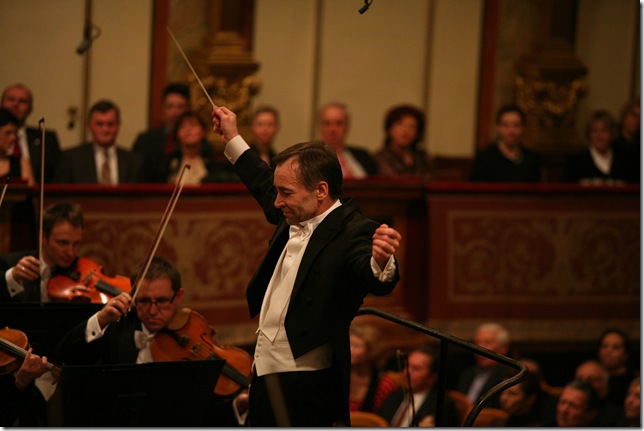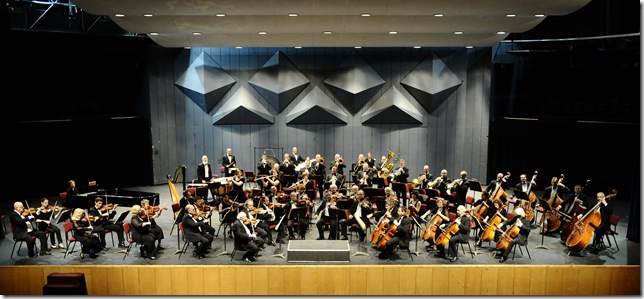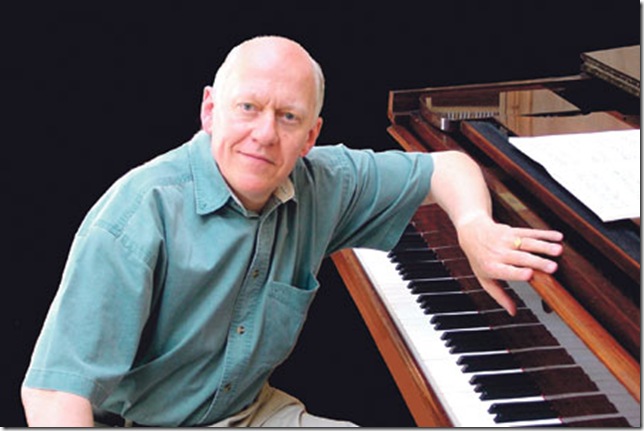By Rex Hearn
The 75 musicians making up Israel’s Haifa Symphony Orchestra play with a refined sound that makes for a very good regional orchestra.
Founded in 1950, two years after the declaration of the state of Israel, they were led on their appearance Tuesday night at the Kravis Center by their principal guest conductor, the distinguished Polish musician Boguslaw Dawidow.
A full house heard a most unusual Mozart 40th Symphony (in G minor, K. 550). Taken at a very subdued, slow pace, every detail of the first movement was carefully and lovingly brought out. It was a sublime interpretation. In the next movement (Andante), the violins’ melodious theme and harmony clashed to make for tense moments. Then double pianissimos at the end, played so sensitively and quietly, kept that audience rapt.
I felt the Menuetto third movement lacked attack, but the conductor and orchestra kept it together, moving along at this remarkably slow pace. They emphasized each of the many tunes Mozart presents, letting the audience pick out which they might like, so deliberate was their delivery. Magnificent playing from the horn section and winds was heard here as the exposition and fugue played out.
The final movement got off to a fast start, in contrast with the other slower first three movements. The difference was stark. The main ascending motif was exquisitely played by the strings, especially the violins. What possessed the conductor to take most of the symphony at such a slow pace? The balmy Mediterranean climate of Haifa? Was he being overcautious on the road?
This is undoubtedly a fine body of musicians, so perhaps the program notes provided a clue. Dawidow said there that Leonard Bernstein was his most significant influence, and Bernstein’s last appearance was to conduct Beethoven’s Third Symphony at a snail’s pace, bringing out all the beautiful music. The public were aghast at first, but soon rallied to appreciate the recording he made at Tanglewood with the Boston Symphony. Haifa’s performance of Mozart’s 4oth will remain in the memory for a very long time; perhaps this was Dawidow’s aim.
Next followed a new piece by Uri Bracha, Melodies for Mount Carmel, a viola concerto played by Avshalom Sarid. A sweet, lilting viola statement opens with orchestral accompaniment. Sarid, an excellent soloist, went forward followed by rhythmic strings and a plucked guitar. It is beautiful, accessible music that ends on a unified harmonious chord from the strings.
The next movement was a jewel. Oboe and guitar open by taking the tune from one another which leads to the viola joining them in recognizable Jewish traditional songs, combined with Western themes. Here Sarid was really getting into his playing. A splendid technique and lovely intonation and Sarid’s pleasant personality made him an audience favorite.
Cuban-style drumbeats began the third movement. I sensed a little raggedness in the orchestral playing in the middle. A few dissonant chords are heard occasionally. Four chords from the orchestra led to a magnificent cadenza, with interesting guitar interjections, which were most effective. The orchestra picks out the original theme. Viola and orchestra question each other as the concerto ends on a warm reassuring note. The work may well get more exposure now.
Sarid played a lovely Hasidic melody for an encore.
Tchaikovsky’s Sixth Symphony, the Pathetique (in B minor, Op. 74), ended the program. Another slower than usual start; the second tune lacked urgency, heartfelt yearning and the romantic sweep of the strings leading to the massive kettledrum awakening. There was great work here from the trombones, masterful playing and some nice downward scales from the double basses.
In the second movement’s waltz theme the cellos made the melody stand out beautifully. It was a masterful interpretation from conductor and orchestra of this lilting music. The famous rousing march of the third movement had what I’d call “controlled vivaciousness.” Obviously well-rehearsed to the point of perfection, the tune is passed around from section to section, broken by an angry outcry from the timpani. The music builds to a flourishing intensity, which is always met by thunderous applause, though the symphony has not ended.
Most conductors allow the clapping to die away before commencing. Dawidow played through the din, which I feel is disingenuous to the players, deserving of the applause at this time. Incidentally there are no rules about when to applaud. In centuries past, the public met every “break” with applause; only in the 20th century, for continuity’s sake, was applause in the middle of a multi-movement work discouraged.
The anticlimactic last movement is not the brilliant traditional finale we expect, but dies to nothingness at the end. It is marked Adagio lamentoso. Tchaikovsky died 10 days after its first performance.
Alas, hesitation and unclear baton movements from the conductor as the music faded away led to a debacle of mixed unsure handicapping. It’s understandable that nobody wanted to break the mood, but poor leadership deprived these fine musicians of an overwhelming roar of approval. The conductor’s baton must be dropped firmly next time, signifying the end.
Encores were John Williams’ fine Schindler’s List theme and John Philip Sousa’s The Stars and Stripes Forever.
****
By Greg Stepanich
Doubtless it’s been decades since anyone played Christian Sinding’s Rustle of Spring in concert in South Florida, though many yellowed copies of this once-standard piano favorite are probably sitting in cabinets in the local homes of elderly people who studied the piano in their youth.
The same goes for a piece like Ignace Paderewski’s Minuet in G, which was also featured on a program Jan. 25 by the fine British pianist and teacher Philip Fowke, who took his audience at Lynn University’s Amarnick-Goldstein Concert Hall through an entire half of a program devoted in part to once-popular but now-forgotten encores. And then there’s Billy Mayerl — but more on him later.
Fowke, who was in town for the 10th iteration of Lynn’s Guest Pianist Weekend, is a professor of piano at London’s Trinity College of Music, and his presentation had a refreshingly avuncular, self-effacing style that was thoroughly charming and informative. The second half of his recital was the Art of the Encore, but the first was all performance.
Although Fowke scheduled a classic Chopin group of three masterworks by the Polish composer, he opened with another relatively obscure piece, the early 15 Hungarian Peasant Songs of Béla Bartók. Piano students run into this work a good bit, but it doesn’t get heard much in concert, and that’s a pity.
Early Bartók, such as this piece and the better-known Romanian Folk Dances, is music of tremendous integrity; the folksongs he and Zoltan Kodaly collected in their excursions throughout the Hungarian regions of Europe in the first decade of the last century are given serious settings of harmonic inventiveness without using them merely as hints for some unrelated compositional excursion.
So the music, while modern and fresh, is also music of the people. The texture of the work is relatively simple, as well as very clear and direct, and much of the melodic material is quite similar. Fowke played this music with purity and strength, and did a fine job of bringing out the work’s varieties, which are often suddenly imposed, going in a flash from stomping to skipping. Contrast is key in a work like this, and Fowke gave it plenty.
Three Chopin works followed: the Ballade No. 1 (in G minor, Op. 25), the Ballade No. 3 (in A-flat, Op. 47), and the Andante Spianato and Grande Polonaise (Op. 22). These, too, are core teaching pieces as well as staples of the literature, which tends to make them over-familiar. But Fowke did them well, demonstrating admirable technique in the big runs and sparkling ornamentation in the First Ballade, and an almost offhand way of stating the opening theme in the Third Ballade that let him take the rest of the piece wherever he wanted to go.
Fowke drew more poetry out of the Andante Spianato, perhaps because the spinning-song accompaniment sets a stable mood that needs real contrast to make its full impact. The polonaise that followed again showed how large his technique really is, which speaks to his busy concertizing schedule and suggests that his students are getting training from someone who really knows his way around a keyboard.
The second half was a presentation of encore music, primarily from about a century ago, music that was once a staple of every touring pianist’s repertoire and now has been replaced by works of greater weight. Fowke thinks this is a shame, and he’s largely right; the best recitals tend to be ones that have the highest contrast of repertoire, though almost always of first-drawer repertoire. Lighter works these days tend to be stigmatized as somehow unworthy, but when the composer is the caliber of Edvard Grieg, that’s a different story.
Fowke played two of the composer’s Lyric Pieces: the Melody (Op. 47, No. 3) and Butterfly (Op. 43, No. 1), the first hardly known and the last quite familiar (you can hear Grieg himself play it on a Wikipedia sound file). These are both distinguished pieces, and the Melody in particular has a haunting harmonic flavor underneath its folksong tune. The Padereweski minuet is a charming piece, undeservedly neglected, and honest in its simplicity. Fowke played all three with high style and conviction, and they were lovely.
The Sinding Rustle of Spring has never been a good piece, and somehow Fowke’s playing of it, powerful and intense, merely confirmed that. But he did pianists everywhere a real service by offering the Third Rhapsody of Ernst von Dohnanyi, a marvelous pianist and very good composer who ended his days as a Florida State professor. This Rhapsody is a beautiful, inventive piece, expertly written for the piano, and Fowke made an excellent case for it as an encore selection.
He also gave us two pieces by the early 20th-century British pianist and composer Billy Mayerl, who was a staple of the BBC Light Programme in the 1930s and 1940s. Fowke played two of his pieces, one of them his signature tune, Marigold. This is amusing but forgettable music of a light-jazz type that doesn’t translate well across the pond; the British have their own corps of light music masters such as Mayerl and Eric Coates, among others, whose appeal seems to be purely local.
After the Mayerl, Fowke played the Boogie-Woogie Etude of American composer Morton Gould, which is a terrible piece, but it got a terrifically energetic performance. But Fowke made his point with the Dohnanyi and the Grieg, and also with a flawless reading of Moritz Moszkowski’s Etincelles (Sparks, Op. 36, No. 6).
The Moszkowski is only in the repertoire again because Vladimir Horowitz played it on his late-career tour of the Soviet Union, which goes to show that if a good pianist makes the right advocacy for something, forgotten repertoire has a chance to return to listeners’ and performers’ good graces. May it be so with some of the better Grieg Lyric Pieces, and with the Dohnanyi Rhapsodies; those who were in the audience at the Amarnick last weekend will know whom to thank.


